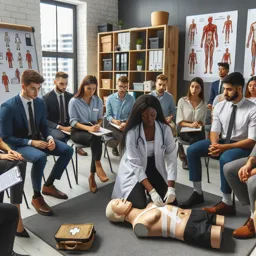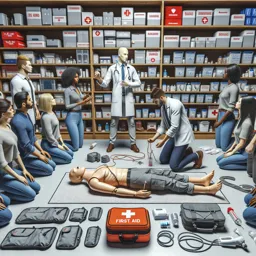Introduction
Accidents and injuries can occur at any workplace, whether it’s a bustling office, a busy construction site, or a quiet retail store. Having a solid understanding of workplace first aid can make a significant difference in minimizing the severity of injuries and ensuring a swift response during emergencies. In this article, we’ll explore common workplace injuries and how basic first aid can help protect employees and reduce risks.
Typical Workplace Injuries
- Cuts and Lacerations: These can happen when using sharp tools, machinery, or even paper. While many of these wounds are minor, some may require immediate attention.
- Burns: Burns may result from contact with hot surfaces, chemicals, or electricity. Quick and appropriate first aid can prevent further tissue damage and allay pain.
- Sprains and Strains: Lifting heavy objects or repetitive movements can cause muscle or joint injuries. Prompt care helps reduce swelling and speeds up recovery.
- Slips, Trips, and Falls: These are among the most frequent workplace incidents, leading to bruises, fractures, or even head injuries.
- Eye Injuries: Debris, chemicals, or accidental impact can harm the eyes. Immediate first aid is crucial for protecting eyesight.
Basic First Aid Steps for Common Injuries
Cuts and Lacerations
- Wash your hands or use gloves if available.
- Apply gentle pressure with a clean cloth to stop bleeding.
- Rinse the wound with clean water and cover it with a sterile bandage.
- Seek further medical help if the cut is deep or won’t stop bleeding.
Burns
- Cool the burn under running water for at least 10 minutes.
- Remove any tight items, like rings or watches, before swelling occurs.
- Cover with a loose, sterile dressing.
- Do not apply creams or break blisters.
Sprains and Strains
- Rest the affected limb and apply an ice pack wrapped in cloth.
- Elevate the injured area to reduce swelling.
- Compression using an elastic bandage can help but should not be too tight.
Slips, Trips, and Falls
- Assess the person for any head, neck, or back injuries before moving them.
- If minor, help them sit and rest; apply ice to any bruises.
- If in doubt about the severity, seek medical help immediately.
Eye Injuries
- Rinse the eye with clean water or saline solution immediately.
- Avoid rubbing the eye or trying to remove embedded objects.
- Seek professional medical care as soon as possible.
Importance of First Aid Training
Prompt and correct first aid responses can save lives and reduce the impact of injuries in the workplace. Regular first aid training ensures that employees are prepared for emergencies, understand how to use first aid kits effectively, and can react calmly and efficiently under pressure.
Conclusion
Understanding common workplace injuries and having proper first aid knowledge creates a safer environment for everyone. Encouraging regular first aid training and maintaining accessible first aid kits are key components of a proactive workplace safety culture.




























